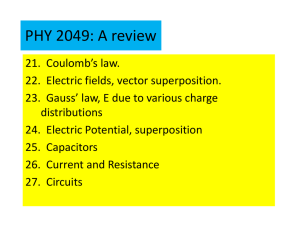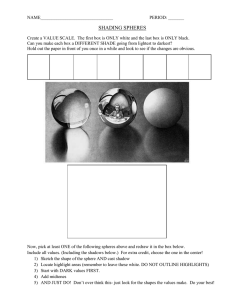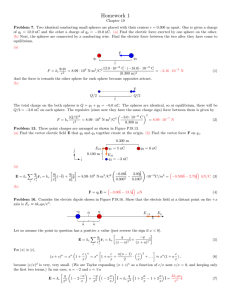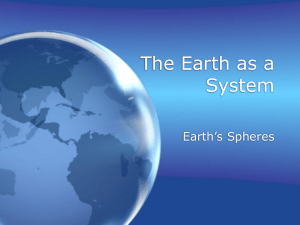ENERGY LOSS IN SPHERES BY PENETRATING ELECTRONS J
advertisement
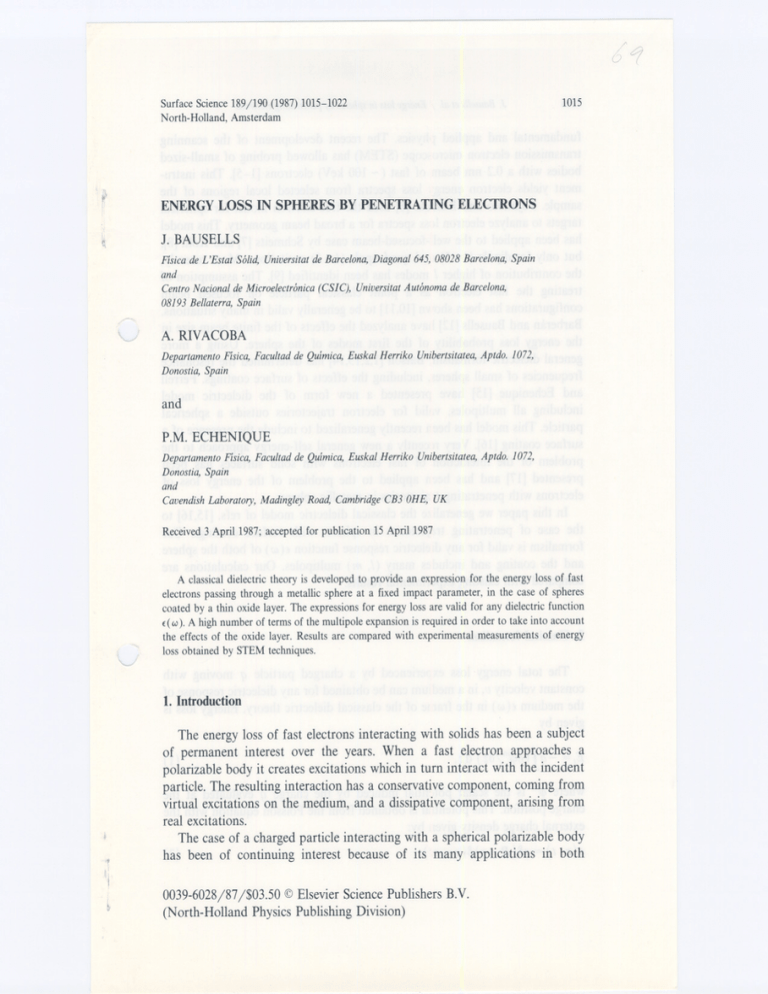
1015
Surface Science 189/190 (1987) 1015-1022
North-Holland,
Amsterdam
ENERGY LOSS IN SPHERES BY PENETRATING ELECTRONS
J. BAUSELLS
Física de L'Estat
and
Sólid, Universitat de Barcelona, Diagonal 645, 08028 Barcelona,
Centro Nacional de Microelectrónica
(CS/C),
Universitat Autónoma
Spain
de Barcelona,
08193 Bellaterra, Spain
A. RIVACOBA
Departamento Física, Facultad de Química, Euskal Herriko
Donostia, Spain
Unibertsitatea,
Aptdo. 1072,
Unibertsitatea,
Aptdo. 1072,
and
P.M. ECHENIQUE
Departamento Física, Facultad de Química, Euskal Herriko
Donostia, Spain
and
Cavendish Laboratory,
Received
Madingley
3 Apri11987;
accepted
Road, Cambridge
for publication
CB3 OHE, UK
15 April 1987
A classical dielectric theory is developed to provide an expression for the energy loss of fast
electrons passing through a metallic sphere at a fixed impact parameter, in the case of spheres
coated by a thin oxide layer. The expressions for energy loss are valid for any dielectric function
( w). A high number of terms of the multipole expansion is required in order to take into account
the effects of the oxide layer. Results are compared with experimental measurements of energy
loss obtained by STEM techniques.
l. Introduction
The energy loss of fast electrons interacting with solids has been a subject
of permanent interest over the years. When a fast electron approaches a
polarizable body it creates excitations which in turn interact with the incident
particle. The resulting interaction has a conservative component, coming from
virtual excitations on the medium, and a dissipative component, arising from
real excitations.
The case of a charged particle interacting with a spherical polarizable body
has been of continuing interest because of its many applications in both
0039-6028/87/$03.50
(North-Holland
@
Elsevier Science Publishers B.V.
Physics Publishing
Oivision)
1016
J. Bausells et al. / Energy /oss in spheres by penetrating e/ectrons
fundamental and applied physics. The recent development of the scanning
transmission electron microscope (STEM) has allowed probing of small-sized
bodies with a 0.2 nm beam of fast ( 100 keV) electrons [1-5]. This instrument yields electron energy loss spectra from selected local regions of the
sample. Fujimoto and Komaki [6] used the free-electron model for spherical
targets to analyze electron loss spectra for a broad beam geometry. This model
has been applied to the well-focused-beam case by Schmeits [7] and Kohl [8],
but only for dipole (l = 1) and quadrupole (l = 2) excitations. More recently,
the contribution of higher 1 modes has been identified [9]. The assumption of
treating the fast electron as a point classical particle on focused beam
configurations has been shown [10,11] to be generally valid in many situations.
Barberán and Bausells [12] have analyzed the effects of the finite beam size in
the energy loss probability of the first modes of the sphere. Using a more
general dielectric formalism, Batson [1,2,13,14] has determined the resonance
frequencies of small spheres, including the effects of surface coatings. Ferrell
and Echenique [15] have presented a new form of the dielectric model
including all multipoles, valid for electron trajectories outside a spherical
particle. This model has been recently generalized to include the presence of a
surface coating [16]. Very recently a new general self-energy approach to the
problem of the interaction of fast electrons with solid surfaces has been
presented [17] and has been applied to the problem of the energy loss of
electrons with penetrating trajectories in metallic spheres.
In this paper we generalize the classical dielectric model of refs. [15,16] to
the case of penetrating trajectories in spheres with surface coatings. Our
formalism is valid for any dielectric response function f( W) of both the sphere
and the coating and includes many (l, m) multipoles. Our calculations are
compared with existing experimental results.
-
2. Classical fonnalism
The total energy loss experienced by a charged particle q moving with
constant velocity v, in a medium can be obtained for any dielectric response of
the medium f( w) in the frame of the classical dielectric theory. Energy loss is
given by
E¡= -qf(acpin/az)
dz,
(1)
where cpinis the scalar potential induced by the charge q evaluated at the
charge position. This potential is obtained from the Poisson equation with the
external charge density given by:
p (r, 1) = ql>(R - s) l>(z - VI),
(2)
J. Bausells et al. / Energy loss in spheres by penetrating
1017
electrons
v
e
Fig. 1. Charged
particle
q moving at impact parameter s near two concentric
radü a and b, and dielectric responses f1 and f2'
dielectric
spheres of
where z has been taken in the same direction as the particle velocity and R is
the transversal component of the r vector. The induced potential is:
cpin(r, t) = 21'1T!W(r, r', w) e-iw(t-t')p(r',
t') dw dt' dr'.
(3)
W( r, r', w) is the Fourier w-component of the potential created by an unit
charge at rest in point r', at point r.
For the case of a charged particle interacting with two concentric dielectric
spheres, of radii a and b and dielectric response ll(w) and l2(w) (fig. 1), the
induced potential cpincan be easily obtained from standard electrodynamics by
means of a multipole expansion of this potential. In such a way the energy loss
can be written as:
00
(4)
E/= 10 wPAw) dw,
we use atomic units throughout. The energy-Ioss probability Ps(w) is given by:
2
ps(w)=L~L
1
a (V'1T)
/
L (2/+1)(2-8mo)(!-m)!j(!+m)!
/ m=O
X {a/( w )/l~ + 2y/( W)11112/+ 2f3/( W)11113/+ 28/( W)11114/
+ 21//( W)/2~ - 2S/( W)/2d3/ + 2p/( w)/2d4/
+p2/+1 [8/(w )/3~ + 2v/(w )/3d4/ + ~/( w )/4~]}'
(5)
where 8mO is the Kronecker delta. Functions al( w), f31(w) and so on are the
imaginary part of the response functions given in the appendix. The remaining
1018
J. Bausel/s et al. / Energy loss in spheres by penetrating electrons
function /11' /ZI etc. are the real part (for 1+ m even) or imaginary
I + m odd) of functions
oo
.
¡
¡
¡
/4/= ¡ P1m(Z/r) e-'wz V(r/a)
/11=
ra
P1m(z/r)
e-,wz/V(a/r)
P1m(Z/r)
e-'wz V(a/r)
P1m(Z/r)
eiwz/v(r/a)
ra
/Z/=
.
part (for
1+1
dz
1+1
/
dz
rb
ra
/31=
1
dz
rb
O
.
/
ra
1
dz
(6)
Here P1mare associated Legendre functions, r = (zz + SZ)l/Z and ra and rb
are the distances between the z = O plane and the intersection of the particle
trajectory with the spheres.
The loss due to buIk terms has not been included in eq. (5). To calculate the
total energy loss one has to add in eq. (5) the well known expression for the
bulk energy loss [19].
3. Results and discussion
The preceding formalism has been applied to the case of 100 keV electrons
incident on an aluminium sphere of radius 200 au coated by an Alz03 layer.
We use experimentalvalues of the f( w) response functions for both materials
[20]. In order to get good convergence in our calculation more than forty I
multipole terms were generally required. In fig. 2 we show the energy loss
probability Ps(w) as a function of the energy w for three values of the impact
parameter s. The thickness of the oxide layer is 40 au. The peaks at 7.2 eV
correspond to the surface aluminium modes and their positions are independent of the impact parameter. The peak height has a maximum value when the
incident trajectory crosses near the AI-Alz03 interface. In fig. 2a the peak at
15.1 eV correspond to the bulk Al mode.
Fig. 2b has been obtained for an impact parameter s = 210 au and the
incident trajectory passes through the Alz03 layer. For w values above 10 eV
the energy loss probability coincides qualitatively with the probability obtained for an electron incident axially over an Alz03 sphere of similar size.
The peak at 24.4 eV is the bulk Alz03 mode. This mode should be responsible
of the fact that in fig. 2a the loss probability in this energy region decreases
more slowly than in an oxide-free Al sphere. [18]
In fig. 2c the electron trajectory is outside the spheres. Our results then
reproduce those of reí. [16]. In OUTapproximation only surface modes contribute to the energy 10ss probability. Therefore the 10sses above 10 eV can be
J. Bausel/s et al. / Energy /oss in spheres by penetrating
"
e/ectrons
1019
(e)
3
2
o
oJ
(b)
x
'33
a..V!2
x12
(a)
:r
2
o
5
10
15
w (eV)
20
25
Fig. 2. Energy loss probability as a function of the energy w for an electron incident over an Al
sphere of radius 200 au with an AI20 layer of thickness 40 au. (a) Axial trajectory. (b) Impact
parameter s = 210 au. (e) Impact parameter s = 250 au.
interpreted as due to surfaee modes of the oxide. From our ealculations the
maximum loss appears in the neighbourhood of 15.5 eVo This surfaee losses
presumably eontribute the loss probability in the energy region of 10-20 eV of
fig. 2b.
The results of figs. 2a and 2e are in good qualitative agreement wi.th the
experimental results of Batson and Treaey [21]. The faet that the Al surfaee
mode peak position doesn't depend on the impaet parameter was also observed in the same work. Also, the qualitative behaviour of the Al surfaee
mode peak height in ref. [21] agrees with our results.
1020
J. Bausells et al. / Energy loss in spheres by penetrating electrons
&A)((.IV)
&.5
80
7.5
7.0
6.5
o
25
50
75
100
L(a.u.)
Fig. 3. Position of the Al surface mode peak as a function
of the oxide thickness
L1= a-b.
In fig. 3 we show the dependence of the Al surface model peak position on
the thickness of the oxide layer. The radius of the Al sphere is 200 au and the
electro n trajectories are axia!. For small oxide thickness the peak po sitio n
tends to the bare Al result wp/ {3 = 8,7 eV for 1= 1 and for big oxide
thickness it approaches the result for an Al sphere surrounded by an infinite
Al203 medium, which is 5.2 eV for E:ox=
3.73.
Acknowledgements
One of the authors (P.M. Echenique) gratefully thanks Professor A. Howie
for many stimulating conversations and Iberduero for help and support.
Authors wish to thank Gipuzkoako Foru Aldundia for support. One of the
authors (A. Rivacoba) thanks the Basque Country Government for support.
J. Bause/ls et al. / Energy /oss in spheres by penetrating e/ectrons
1021
Appendix
al ( w )
4'1T
1
4'1T (1-f3)
'YI( W) = 1+ 1
.1
4'1T
t'
(W ) =
_~
1+ 1
f3
)( 1 +
---¡-f2
)-
1+1
2/+1
(1 - f2 )(1 + ---¡-f3 )] .
P
.
2/+ 1 1
( )
/31 W = - 1+ 1 P
UI
1+1
1
= 21+ 1 1+ 1 Ll[( 1 -
Ll(1 +
21+ 1
2/+1
1 P
1+ 1
Tf3
).
~
.1 .
_ 4'1T (1-f2)(1+f3(1+1)/1)
( )
81 w - 2/+1
f2.1
.
4'1T 1+ 1 1
~/( w) = 21 + 1 ---¡- .1f1
X {(1- (2)[1 + f31/(I + 1)] - p2/+1(1- (3)[1 + f21/(I + 1)]}.
4'1T (1 - (3)[1 + f21/(I + 1)]
~/= 2/+1
.1f2
.
4'1T (1-f2)(1-f3)
tl= - 2/+ 1
f2.1
.
4'1T 21+11 + f21/(I + 1)
JLI=-¡P
f1.1'
4'1T(1-f2)
vl=¡
f1.1
.1 = (1 - f 2)(1 - f 3) - [1 + f 3( 1+ 1)/1][ 1 + f 21/ (1 + 1)] p21+ 1 .
f2
f3
= ~'1 p = albo
References
[1]
[2]
[3]
[4]
P.E. Batson, Ultramicroscopy
9 (1982) 277.
P.E. Batson, Phys. Rev. Letters 49 (1982) 936.
J.M. Cowley, Surface Sci. 114 (1982) 587.
A. Howie, Ultramicroscopy
11 (1983) 141;
P.M. Echenique and A. Howie, Ultramicroscopy
16 (1985) 260.
[5] C. Colliex, Ultramicroscopy
18 (1985) DI.
[6] F. Fujimoto and K. Komaki, J. Phys. Soco Japan 25 (1968) 1679.
1022
J. Bausel/s et al. / Energy loss in spheres by penetrating
electrons
[7]
[8]
[9]
[10]
[11]
[12]
[13]
[14]
M. Schmeits, J. Phys. C14 (1981) 1203.
H. Kohl, Ultramicroscopy
11 (1983) 53.
M. Acheche, C. Colliex, H. Kohl, A. Nourtier and P. Trebbia,
R.H. Ritchie, Phil. Mag. A44 (1981) 931.
R.H. Ritchie and A. Howie, to be published.
N. Barberán and J. Bausells, Phys. Rev. B31 (1985) 6354.
P.E. Batson, Solid State Cornmun. 34 (1980) 477.
P.E. Batson, Surface Sci. 156 (1985) 720.
[15]
[16]
[17]
[18]
[19]
[20]
[21]
T.L. Ferrell and P.M. Echenique, Phys. Rev. Letters 55 (1985) 1526.
P.M. Echenique, A. Howie and D.J. Wheatley, Phil. Mag., to be published.
P.M. Echenique, J. Bausells and A. Rivacoba, Phys. Rev. B35 (1987) 1521.
J. Bausells, Proc. 10th W. Brand Workshop, Alicante, 1987, to be published.
R.H. Ritchie, Phys. Rev. 106 (1957) 874.
H.J. Hageman, W. Gudat and C. Kunz, Desy Report SR 74/7 (1974), unpublished.
P.E. Batson and M.J. Treacy, Proc. Electron Microsc. Soco Am., San Francisco, 1980, Ed.
G.W. Bailey.
---
Ultramicroscopy
20 (1986) 99.

